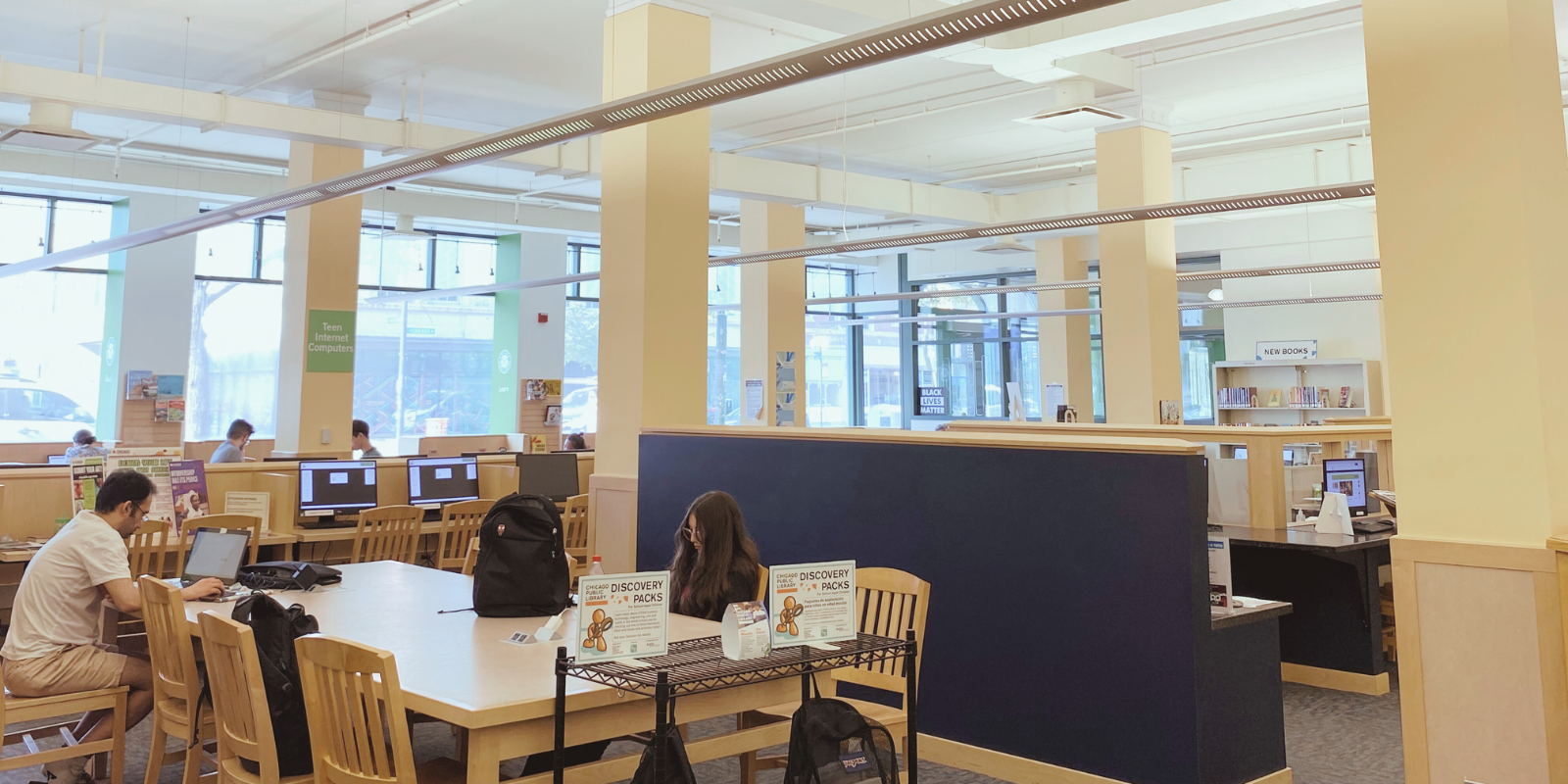The five-story former Goldblatt’s Store is at 1613-35 W. Chicago Ave., near Ashland Ave. Photos by Lois Kimmelman.
By Lois Kimmelman, LEED AP
Three mayors ago, in the City that Works, the original Goldblatt Bros. Department Store sat empty on Chicago Avenue near Ashland Avenue, in the City’s bustling West Town neighborhood. A shadow of its former distinguished self, the structure was slated for demolition, to be replaced by a Del Ray Farms supermarket. Enter a group of community activists and preservationists, whose objections to the razing prompted the City to buy the vacant store in 1997 and recast it as a municipal office building. The structure, now a Chicago landmark, underwent an extensive rehab to accommodate a senior center, the Chicago Department of Family Services and other City agencies. More recently, part of it was remodeled again to become the West Town branch of the Chicago Public Library.
The old Goldblatt’s on Chicago Avenue is actually two adjacent structures designed by Alfred Alschuler. The first is a brick three-story edifice built in 1922. The second, a five-story, 200-foot-long “addition” built in 1928, reigns over the block. It boasts an intricate gray terra-cotta façade, “good bones", some intriguing artwork, and a full range of sustainable elements. Not to mention a fascinating history.
The painting Goldblatts’ Ghosts, by Jim Lutes, depicts the store during its more popular days.
In its heyday, Goldblatt’s was synonymous with bargain-hunting. “We Will Not Be Undersold” was the company motto. From the late 1920s through World War II, shoppers flocked to the Chicago Avenue store to buy suits, candy, furniture, garden supplies, and even pets. The company as a whole was thriving and expanding; several other Goldblatt’s stores were constructed around the city.
Then in 1944, tragedy struck. One of the two founding Goldblatt brothers died at age 49 and two years later the surviving founder turned the business over to his two younger brothers. Gradually the company began to struggle, and in 1981, facing competition from discount retail giants like Kmart, it declared bankruptcy. In a last gasp, Goldblatt’s reopened the Chicago Avenue store and some at other locations. But in 1996 the grande dame on Chicago Avenue was shuttered, and by 2003 all the other stores were closed for good.
The Chicago Avenue store made front-page news in 1952 when a gang of burglars broke into the executive offices on the fifth floor. One August night, they waited till the store closed at 9:30 p.m., climbed a fire escape to the roof, then descended to the top floor via a ladder attached to the four-story vertical GOLDBLATTS sign that hung from the front of the building. The robbers crept through an unlocked window and made off with about $50,000 in cash pigeonholed in the office walls.
In the post-Goldblatt’s era, the building continued to be newsworthy, but for different reasons. Its revival in the late 1990s, led by architectural firm Holabird & Root, transformed what had become a dilapidated, rat-infested hulk with a flooded basement into well-lit city office spaces and welcoming entryways. Seventy-year-old building components like the central staircase and columns were saved, while the space was upgraded with new elevators and state-of-the-art HVAC equipment and plumbing.
During the makeover, the gray terra-cotta façade with its broad “Chicago windows” was meticulously restored, and additional windows were punched in the rear and side brick walls, allowing even more daylight into the interior.
Exterior murals frame some of the windows on the east side.
The three-story red brick abuts the five-story structure.
Just as notable was the construction of the library on the first floor in 2010. The team lead for that project, Interactive Design Architects (IDEA), reused materials wherever possible. For example, the white marble floor that graces the library entrance is recycled from the marble found in the old Goldblatt’s store offices. Water-saving bathroom fixtures, energy-efficient lighting, and insulated windows were installed as well. Result: the library achieved LEED Gold status in 2012.
Visiting the old Goldblatt’s to cast your vote or check out a book? Take a good look around and you’ll see an impressive blend of the historic and the modern.
Read more about historic buildings getting a green makeover on Lois Kimmelman’s website/blog, Historecycle. She promotes restoration and renovation, not demolition.
The former Goldblatt’s now houses the Chicago Public Library, West Town Branch.





